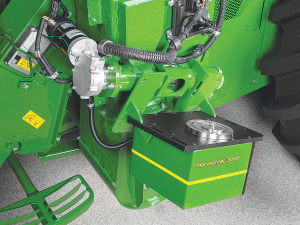John Deere launches Harvest Profit in NZ & Australia
Recently released in Australia and New Zealand by John Deere, a unique new software platform offers near real time profitability monitoring across crops and individual paddocks.
 The HarvestLab 3000 Grain Sensing on JD's S700 Series Combines offers the ability to continuously measure and monitor protein, starch, oil and moisture values.
The HarvestLab 3000 Grain Sensing on JD's S700 Series Combines offers the ability to continuously measure and monitor protein, starch, oil and moisture values.
New Zealand's broadacre farmers are now able to access a complete picture of profitability with the launch of John Deere’s HarvestLab 3000 Grain Sensing on S700 Series Combines.
The machine was originally introduced to the forage industry in 2007 as HarvestLab, then upgraded to HarvestLab 3000 in 2017.
Now the systems sensor capabilities have been extended for use in the grains sector. This offers the ability to continuously measure and monitor protein, starch, oil and moisture values in wheat, barley or canola during real time during harvesting. The data can be viewed in the cab, or in John Deere Operations Center™. This allows farmers to make critical marketing and management decisions before the grain has left the field.
HarvestLab 3000 offers customers new-level insights into the quality of their crop and input effectiveness. It is available as a field kit, having undergone two years’ worth of testing with Australian farmers.
“Currently, most farmers usually assess samples of grain with a stationary protein analyser back in the shed,” explains John Deere Precision Ag Manager, Benji Blevin.
“HarvestLab 3000, will offer a complete map of grain quality, which can be overlaid with a yield map. Farmers can see exactly what parts of their paddocks are producing the highest quality grain.
They will also be able to utilise HarvestLab 3000 to plan future fertiliser programs based on how successfully nutrients were converted into yield, protein, starch, or oil.”
The technology works as the combine moves through the paddock, with a motor-driven auger pushing grain past the Harvest- Lab 3000’s near-infrared sensor. Together with the StarFire™ receiver, site-specific data is generated on the Generation 4 Display and sent to Operations Center via JDLink™.
HarvestLab 3000 is available to order from April for easy integration into 2018 or later S700 Series Combines, before the 2023 harvest season.
Engaging, thought provoking speakers, relevant seminars and relatable topics alongside innovative produces and services are the order of the day at the 2026 East Coast Farming Expo.
Farm supplies trader Ruralco has recovered from two consecutive years of losses to post a $1.25 million profit for the 2025 financial year.
Naki Honey, a New Zealand manuka apiary company, has crafted what is believed to be the world's most expensive honey.
OPINION: Wool farmers believe the future of strong wool still holds promise.
Applications are open for Horticulture New Zealand's (HortNZ) 2026 scholarship programme, with 20 funding opportunities available.
OPINION: Farmers are being asked to celebrate a target that changes nothing for the climate, wastes taxpayer money, and ignores real science.

OPINION: The Greens have taken the high moral ground on the Palestine issue and been leading political agitators in related…
One of the most galling aspects of the tariffs whacked on our farm exports to the US is the fact…